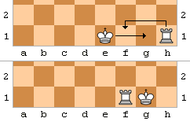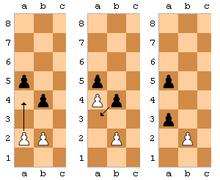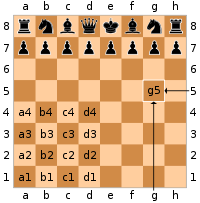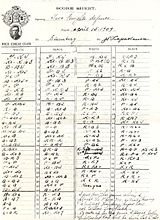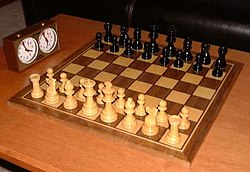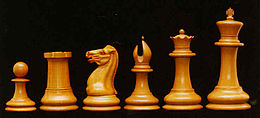Rules of Chess
The chess laws are the rules or regulations established FIDE to practice the Chess.1The latest version of this regulation was adopted in the FIDE Congress 87 held in Baku (Azerbaijan) And entered into force on 1 July 2017.1
although the origin of chess It is not clear, the rules of modern chess began to form in Spain e Italy during the century XVIWhen the works of, among others spread, Lucena, Ruy Lopez, Polerio and, somewhat later, Salvio.2The rules are changing slowly continued until the beginning of the XIX centuryWhen they reached the current form. The rules also vary from one place to another. At present, the International Chess Federation (FIDE), lays down standard rules, with minor modifications made by some national organizations for their own purposes.
Chess is a game for two players in a Board 32 Parts (16 for each player) of six types. Each piece moves differently. The objective of the game is to checkmateThat is, threatening the king of the opponent with the capture until it is inevitable. Games do not necessarily end with checkmate although you can kill the king directly -the players frequently leave if they believe they will lose-. In addition, there are several ways that the end of the game ends in Tables (tie).
In addition to the basic movements of the pieces, the rules also govern the equipment used, the control of time, the conduct and ethics of the players, facilities for players with special needs, the recording of movements using the Chess notation, as well as procedures for dealing with irregularities that may occur during a consignment.
The chessboard
The chessboard is a square divided into 64 squares (called escaques) also square, with distribution 8 x 8, alternately light and dark. Light-colored squares or boxes are called White and the dark ones Black. The board is placed between the players so that the box to the right corner closest to each player is white.3The eight vertical lines of squares are called Columns and eight horizontal lines of squares are called Rows. It is called Diagonal a succession of squares of the same color in a straight line from one edge of the board to an adjacent.4
Initial position of the pieces
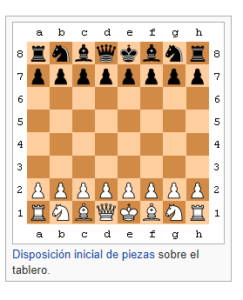
At the beginning of the game each player has the following parts:5
| Piece | Rey | Lady | Torre | Alfil | Horse | Pawn |
|---|---|---|---|---|---|---|
| Amount | 1 | 1 | 2 | 2 | 2 | 8 |
| Symbol |
A principle of the game, the pieces should be arranged as shown in the diagram and discussed below:6
- The board must be so that the slopes off the lower right corner of each player is white.
- The towers are placed at the corners of the board, right and left.
- The horses are placed in the boxes immediately to the side of the towers.
- Bishops are placed in the boxes immediately to the side of the horses.
- The lady is placed in the center square of the same color as the player parts: the white lady in the white box and the black lady in black square.
- The king is placed in the vacant box to the side of the lady.
- The pawns are placed in the next row of the board according to the position where the player is.
Beginners use rules nemotechnics how Lady in her color Y white to the right to remember the correct position of the parts and the board.7
General considerations
- The players move alternately, one of his pieces, except for the case where two castling move, as will be explained later.
- Begins the player who has the white,8which is a small advantage has been that the target gets about 55% of the points at stake compared with 45% of the black, in databases that compile million games.
- If a skid is occupied by a piece of its own, you cannot put another; on the other hand, it is possible to occupy a space that is occupied by an adverse piece, by capturing that piece: that own piece will occupy that escake and the adverse piece will be removed from the game; this fact is called capturing the opposite piece by ours.9
- Each piece has its own way of moving, which is preserved throughout the entire game, including special moves: catches in step of the pawn and Castling.
- The only pieces that can jump are the horses,10or also the towers in the exceptional case of the ring in which it jumps over the king.11By skipping is meant that a part pass in its movement over another piece, either opposing or the same side.
- King of the adversary can never capture. If after a move, the opponent's king happens to be at risk of capture, it is said to be in check. Then the opposing player must make any movement that takes the check to his king, still illegal movement does not involve any such action. If the king is in check and no legal move that allows the king to get the check, it is said to be checkmate, Losing the game the player with the king threatened with capture. The game ends at the moment when checkmate is achieved without performing capturing the opponent's king.
- Con excepción de los peones, las piezas pueden moverse "hacia atrás", es decir en dirección a su respectivo jugador.
Driving the game
The game starts with all parts placed in its initial position on the board (see figure above).
Players must stand in front of each other with the board in the middle, so that both have a white box in the respective right corner. The pieces are placed symmetrically with respect to the players and, with the exception of the lady and the king, also symmetrically regarding the line of sight between players. Considering the row and column nomenclature mentioned above, white must occupy rows 1 and 2, black rows 7 and 8. Thus, each side will place its pieces in its first two rows.
The official rules do not establish procedures to determine who will play with the white pieces. This decision left open by the specific rules of the tournament (for example, a Swiss system Or tournament all against all) Or, in the case of a non-competitive event, by agreement between the players, which can be used some kind of lottery. A common method is that a player hides a part (normally one pawn) of each color in each hand; the other player chooses one hand to open and reveal its color. Then the game starts with whites.
El jugador que controla las piezas blancas se llama "Blanco"; mientras que el jugador que controla las piezas negras se llama "Negro". Como se mencionó, por convención, el jugador con las piezas Blancas comienza la partida y desde entonces se alternan los movimientos. El jugador se ve obligado a hacer un movimiento y no se puede pasar el tiempo, incluso si es desfavorable (zugzwang). The game continues until a player applies checkmate, that is, threatens or captures the opponent's king so that he cannot escape or prevent the attack, or one of the players leaves the game, or declares himself Tables. In addition, if a game is played under time control, the player who automatically exceeds his time loses the game, unless the game is not terminated for any of the above reasons or is the fact that in the final position it is impossible for him to receive matte by any combination of legal plays.
Movement
Basic movements
Each type of chess piece has its own method of movement. A piece moves to a vacant escaque, except when Capture an opponent's piece.
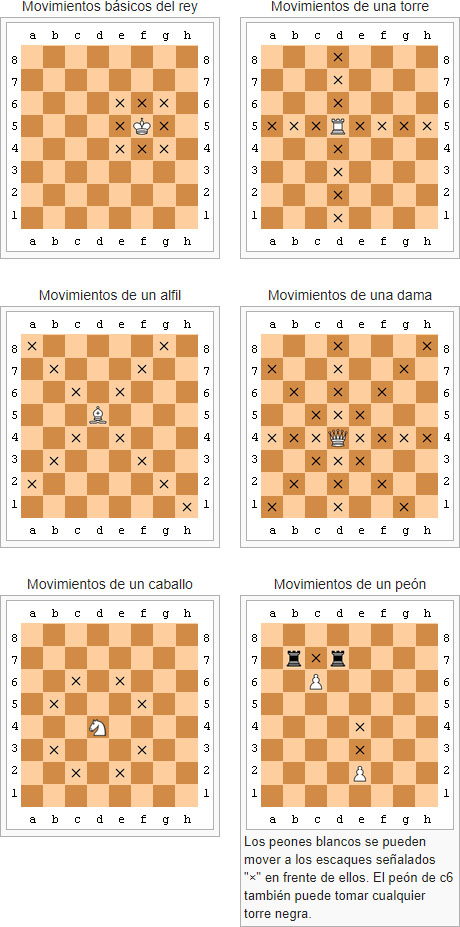
Except for any movement of the horse and casting, the pieces cannot jump over other pieces. A part is captured (or taken) when an attacking adverse part replaces it in its skid (catches in step Or in passant It is the only exception). The captured piece is removed from this mode the game permanently.note 1The king can put in check but can not be captured (see below).
Each move must be made with one hand, including the Castling, For which there is to move the king first and then the tower. Yes there are chess watch it must be pressed with the same hand.
All parts (except horse), regardless of how many squares can move, have limited its scope by other pieces themselves or others. If a piece is in its own way, you can not stop at the slopes off this piece itself, or any other slopes off to get to it, but must go through the busy slopes off. In the case of an alien piece, they not allowed to take them one square through a busy slopes off, however, if possible Capture the part of the adversary, pulling it out of the game and positioning the piece on the slopes off captor occupied by the opposing piece.
- The Tower moves in orthogonal directions, ie, by the (horizontal) rows and columns (vertical) and not being able to move around the diagonals. She can move as many spaces as desired by the columns and rows, but only in one direction each turn.
- The Bishop moves in directions Diagonal, Ie, in the direction of the squares of the same color. You can move as many spaces as desired by the diagonals, but only in one direction (each shift), there is bishop of black slopes and the bishop white slopes offAnd can not change color during the game.
- The Lady You can move many boxes as you want or can, in Diagonal, vertical in horizontally, but only in one direction at each turn. The lady moves with the movements of all other pieces (except the horse) moving as many skies as she wants.
- The King can move in all directions one scan at a time, as long as the movement is not for a skid threatened by an adversarial piece. The king can also capture any adverse piece, as long as he has no other piece defending it. A king cannot check another king.
- The movement of the Horse es en "forma de L", o sea, mueve dos escaques en horizontal o vertical y después un escaque vertical u horizontal, o viceversa. El caballo can jump on any piece of it or the opponent. The capture occurs when a piece of the opponent is in the last run of the movement made by the horse.
- The Pawn has the most complex rules of movement of chess:
- A pawn moves forward a square, if this skid is vacant. If it has not yet moved, the pawn also has the option to move two run-ins forward, as long as both skies are vacant. Pawns can't move backwards.
- Pawns are the only pieces that capture differently from how they move. A pawn can capture an adverse piece in any of the diagonal skies in front of the pawn (but you can't move those skies if they're empty).
- The pawn also participates in the two special moves: step capture and promotion.12
Castling[Edit]
The plaster consists of moving the King two escaques towards the Tower, and then passing the tower to the other King side next to the escaque that the King has just crossed. It is not allowed to move the King and the Tower at the same time, as each movement must be made with only one hand.13The redness is only allowed under the following conditions:
- Neither the King nor the Tower to be screwed up has previously been moved (if the King or the Tower has been removed from the original skid and has returned, it cannot be screwed up). The other tower that doesn't snever, it could have moved.
- The King cannot be in check, or pass or finish the movement in a threatened skid on the board. However, the Tower may be being threatened or go through a threatened escaque, in case of Long rounder during the movement. Likewise, the King may have been in check before, but he can get in check if he has not moved and is no longer in check.
- There is no piece between the King and the Tower, either own or contrary.
- The king and the tower are in the same row (Schiller 2003).note 2
Existen dos clases de enroque: el enroque corto (que se simboliza con 0-0 en las anotaciones de las partidas) y el enroque largo (que se simboliza con 0-0-0). En el enroque corto la torre se sitúa tras la jugada en el escaque del alfil de rey, y en el largo en el escaque de la dama. Por tanto, el enroque corto es el que se realiza en el "flanco de rey" y el enroque largo es el que se realiza en el "flanco de dama".
- See also: Attacks on the rounder
Capture step in step of the pawn
When a pawn is in the fifth skid, or has moved three skies beyond his place of origin and an opponent's pawn, from the column on one side, executes his first move by skipping two skies, fleeing confrontation with the pawn who had moved three skies, the opponent's pawn can be captured at the pace and the catch pawn will occupy the escaque that the opponent jumped when moving two skies. This capture can only be made immediately after the opponent's move (two-skid movement), otherwise it can no longer be done.13
In the old day, the pawn always advanced only one stagger each move. To speed up the game it was decided, at a certain time, that the first time a pawn is played, there is the possibility to overtake two skies. This fact, however, meant that the defensive ability of an opposing pawn could be circumvented. To avoid this, this special move was then established: the catch at the pace of the pawn (a peculiar move that began to be implanted for fundamentally chivalrous reasons, towards the 16th century).
- Position: The black player can make this move if he has a pawn in the fourth row and his opponent has a pawn in the original run in a column adjacent to that of the black pawn. Obviously, White can also capture the step in a symmetrical position to that explained to Black.
- Action that allows it to: with the above position, the opponent (white) advances two steps his pawn from his home scan. The two pawns (black and white) will remain side by side, that is, in the same row and in adjoining columns.
- Mechanism: the black pawn captures the white pawn as if only one row had advanced, but obviously the black pawn will not occupy the escaque that leaves the white pawn empty, but the same one that the white pawn would have occupied if the white pawn had only advanced a escaque.
- Condition: the catch of the pawn at the step can only be done immediately, that is, in the turn following the advance of two skies by the opposing pawn. If it is not done immediately, then it can no longer be done.
Crowning of the pawn
If a pawn advances to the eighth Row, then it must be changed as part of the movement and in the same square by a lady, tower, bishop or horse of the same color, being the player's choice. This choice is not limited to parts previously Captured, it is possible, therefore, for a player to theoretically have nine ladies, or ten towers, or bishops, or horses if all of their pawns are promoted. If the piece to which you wish to promote the pawn is not available, the player must call the referee who will provide the piece.14According to the international referee Eric Schiller, if a suitable piece is not available, a pawn can be used next to the tower and the player indicates which piece it represents. In a formal match with a referee present, the referee must replace the pawn or tower with the appropriate piece. Then the player has the next move.15
Check
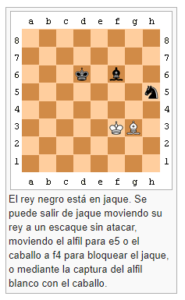
A king is in check when he is being attacked by at least one adverse piece. A piece cannot move because it would put its own king in check (it Immobilizes against his own king) even by offering him check to the opposing player.
A player cannot make any moves that he places or leaves his king in check. Possible ways to get out of check are:
- Move the king to a skid in which he is not threatened.
- Capture the piece that threatens (possibly with the king).
- Block check by placing a piece between the king and the mortal piece of the adversary
If it is not possible to leave the check, the king is in checkmate and the game is over (see next section).
Es costumbre de anunciar "jaque" al hacer un movimiento que pone al rey del oponente en jaque. Sin embargo, en las competiciones oficiales rara vez se anuncia jaque.
Competition rules
Estas reglas se aplican a los juegos disputados "on the board". Hay reglas especiales para el ajedrez por correspondencia, el ajedrez relámpago, el ajedrez por computadora, y para los jugadores con discapacidad.
Act of moving the pieces
The movement of the pieces must be done with one hand. Once the hand releases the piece after it has moved the movement cannot be undone, unless it were an illegal move. When snugging, the player must first move the king with one hand and then move the tower with the same hand.16
Rule of the piece touched
In a serious game, if a player touches one of his pieces during his turn as if he intends to move it, then necessarily the piece must be moved if such movement was allowed. As long as the hand has not left the piece in a new run, the latter can be placed in any accessible run. If the player touches one of the opponent's pieces, he must Capture, if the part could be captured. If none of the played pieces (own or opponent) could be moved or captured with a legal move, there are no penalties.16
During the Castling, the king must be the first piece to be played. If the player touches his tower while touching the king, he must perform the ringing with the tower if possible. If the player completes the two-skid movement with the King without touching the tower, the player must move the correct tower for the cast. If the player starts the ringing, but this one is illegal, he has to make another move with the King if possible, including performing the ringing with the other tower.17
When a pawn moves to its eighth row, once the player has stopped playing the pawn, it can no longer be replaced by a different pawn move. However, the movement is not complete until the piece Promoted get on that run.ts.
Si un jugador desea tocar la pieza con la intención de ajustarla en el escaque del tablero, el jugador debe primero advertir al oponente de su intención diciendo "Compose". Una vez que se inicia el juego, solamente el jugador que tenga el turno puede tocar las piezas en el tablero.16
Conditions for played piece, piece played
- Every player, when he's on his turn, has to move the first piece he plays. If one of the players notices that the pieces on the board are not well centered on their skids, the player who has to play—and only the one who has to play—can adjust one or more pieces in his skies, provided that he previously expresses his intention to do so—for example, saying "compos". The player who is not in turn cannot touch the pieces.
- Unless the player who plays has expressed the intention to "compose" the position, he must play the piece he plays, if he does so deliberately. If a player throws, without intending to do so, any piece of the board, he must recompose the position as soon as possible. If you play with a clock you have to do it at the cost of your time.
- If you touch one or more pieces of your own, you must move the first touched piece. If the first touched piece cannot be moved, you must move the next piece touched if possible and so on if it is not possible.
- If the moving part is left on the board, the piece should be left in that box if it is a legal move.
- If you touch one or more pieces of the opponent, you must Capture the first played piece that can be captured.
- If you touch a piece of each color, you must capture the opponent's piece with yours or, if it is illegal, move or capture the touched piece with another piece of your own. If this is not possible, the own piece touched should be moved.
- If it is impossible to establish which piece was played in the first place, it will be the piece itself that is considered as a piece played.
- If a player deliberately touches his king and tower, he must snuggle up that way if it were legal to do so.
- If a player, intending to roll, touches the king or king and tower at the same time, and it is illegal to roll on that side, the player must make another legal move with his king, including reding on the other side. If the king does not have any legal moves, the player is free to make any legal moves.
- If a player deliberately touches a tower and then their king, he will not be able to roll that way on that play, and must move the tower or the king.
- If none of the played pieces can be moved or captured, the player can make any legal play.
- Whoever must claim that the played piece be played is the opponent, but he must do so before touching a piece, otherwise he loses the right to the claim.
- A touched piece can be played to any legal set. The chosen run is only set when the piece is released or touched by the board. Once released the piece cannot be removed. It is at this time that the move is considered made. If you play with a clock, with the same hand, you have to start the opponent's clock, but not to do so does not prevent the opponent from being able to make his move—with the exception that the opponent must always allow his watch to start after the play is completed—
Timing
Los juegos del torneo se jugarán de acuerdo a ciertas limitaciones de tiempo, llamadas time controls, usando un chess watch. Each player must make their moves within the time control or lose the game. There are different types of time controls. In some cases, each player will have a certain amount of time to make a certain number of moves. In other cases, each player will have a limited amount of time to make all their moves. In addition, the player can gain a little extra time for each move made, either by a small increment added for each move made, or by the clock that delays a small amount of time each time it starts after the opponent's move.18
- If a player performs a checkmate, the game is over and that player wins, no matter what is subsequently observed about the time on the clock.
- If Player A draws attention to player B who is out of time, while Player A is not out of time and some sequence of legal moves leads to B being in checkmate, then Player A wins automatically.
- If Player A does not have the possibility to checkmate B, then the game is on tables (Schiller 2003:28).
The rule of United States Chess Federation (USCF) es diferente. La regla 14E de la USCF define "material insuficiente para ganar en el tiempo", que es el rey solitario, rey y caballo, rey más alfil y rey más dos caballos que no estén en oposición de ningún peón, y no haya victoria forzada en la posición final. De ahí que, para ganar a tiempo con este material, la regla USCF requiere que puede forzarse una victoria desde esa posición, mientras que la regla de la FIDE se limita a exigir que sea posible una victoria (Véase Monika Socko's 2008 rules and the 2008 Women's World Chess Championship for a famous example of this rule.)
- If a player is out of time and also draws attention to his opponent by running out of time, then:
- If a sudden time death control is not used, the game continues in the next time control period (Schiller 2003:23).
- If the game was played under a time control of sudden death, then if you can set which player ran out of time first, the game is lost by that player; otherwise the game is in tables (Schiller 2003:29).
If a player believes that his opponent is trying to win the game on time and not by normal means (i.e. checkmate), if it is a sudden death time control and the player has less than two minutes to the end, the player can stop the clocks and claim boards with the referee. The referee can declare the game tables or postpone the decision and award the opponent an extra two minutes.19
Record of movements
Naming the skies in Algebraic notation
Every skies of the Board is identified by a single pair of a letter and a number. The Rows verticals are pointed out to the H, from the left of White (i.e., the lady's flank) to the right of these. Similarly, Ranges horizontally are numbered 1 al 8, from the closest one next to the white ones on the board. Each dash on the board is then uniquely identified by its row letter and range number. The white king, for example, starts the game in the skid E1. The black horse in b8 can move on to a6 or c6.
In a formal competition, each player is required to record every move in the Chess notation to clear up disputes over illegal positions, overflow game time, and make table statements by the 50-way rule or repeat position. The Algebraic notation is the accepted standard for registering today's matches. There are other systems, such as epistolar notation for chess by correspondence international and the obsolete descriptive notation. The current rule is that the movement must be made first on the board and then annotated on paper or electronic device. Before it became a rule, Mikhail Tal among others were in the habit of writing the movement before doing it on the board. Unlike other players, he did not hide the movement after writing it he liked to observe the opponent's reaction before making the move and sometimes tracked what he had written and scored a different move to play on the board.20
Ambos jugadores deben indicar una oferta de tablas escribiendo "=" al lado de la notación del movimiento en la hoja de cálculo 21Time clocks can be scored, if a player has less than five minutes to complete all his moves, he is not required to record the moves, unless a delay of at least 30 seconds per play is used. The spreadsheet must be available to the referee all the time. The player can respond to the opponent's moves before scoring.22
Final annotations
In tournaments, and for the purpose of computing the results, the winner of a match is awarded one point, half a point to each player who has made tables, and zero points to the loser of a game.
Deferment
If you have to postpone a game, the referee must warn the player at stake to score the secret play, (if the play he makes in the Board it is considered the secret play and should be written as such on the form), once written it must stop the clock, while not stopping the clock can change the secret play.
If a player decides to postpone the game before the end of the session, the remaining time will be charged to their watch.
Irregularities
Illegal movement
When a player moves a piece differently than the way it should be playedNote 3the play is an illegal move. In that case it returns to the previous position, another move is made, but valid, if possible with the same piece, taking into account the rules of the piece played, because the rule of the played piece is applicable, and is rewarded with two minutes of time to the opponent. If in the same game a player makes three illegal moves is given the game for loss, unless his opponent is not in a position to checkmate, in which case tables will be decreed. The referee should set the time on the clock according to the best evidence. If a mistake is only noticed later, the game must be restarted from the play where the error was made.23
If more than one illegal move has been made—for example, several pieces have been moved while a king is in check —the position must be reset until the move before the first illegal move. This is actually only possible if the game has been scored. The new legal move is under the rules of the played piece.
If a fast chess game is being played (in which both players have a small and limited amount of time, for example, five minutes) the rules vary. A player can correct the illegal move if their watch has not been pressed. If the player presses their watch, the opponent can claim a victory if they have not yet moved. If the opponent makes a move, the illegal move is accepted without penalty.24
If, during a game, some parts have been moved from their skies are checked, the pre-irregular position must be restored. If that position cannot be identified, the item shall continue from the last identifiable position prior to the irregularity.24
Illegal position
If a starting position is discovered during the game to be unsuccessful, the game must be resumed. If it is discovered during the match that the board position is incorrect, the game continues with the pieces transferred to a well-oriented board. If the game starts with the colors of the swapping pieces, the game continues (unless the referee specifies otherwise).25Some regional organizations have different rules.Note 4
If a player knocks down the pieces, it is their responsibility to restore them to the correct position using their time. If you verify that you have made an illegal move, or that the pieces are placed incorrectly, the game must be restarted in the pre-irregularity position. If the position cannot be determined, the game must be resumed to the last known correct position.26
Conduct
Players may not use any notes, external source of information (including computers) or advice from others. Analyzing the other dashboard is not allowed. The spreadsheets are to record only objective facts of the game, such as time on the clock, and table offers. Players must not leave the competition area without the referee's permission.27
Se esperan altos estándares de etiqueta y ética. Los jugadores deben darse la mano antes y después de la salida. Por lo general, el jugador no debe hablar durante el juego, excepto para ofrecer una tabla, abandonar el partido, o llamar la atención sobre cualquier irregularidad. El anuncio de "jaque" se hace en los partidos entre los aficionados, pero no debe ser utilizado en partidos oficiales. Un jugador no puede distraer o molestar al oponente de cualquier manera, incluyendo ofrecer repetidamente tablas.28
Equipment
The side of the escaques of the Board should be about 1.25 to 1.3 times the size of the King's base diameter, or 50 to 65 mm. The escaques are approximately 57 mm usually well suited for parts with kings preferably in the appropriate size range. Dark escaques are usually brown or green and the white ones are creams or Before.
The set of drawings of the Staunton pieces son estándar y por lo general son de madera o de plástico. Normalmente son blancas y negras, aunque se pueden utilizar otros colores (como una madera oscura o incluso roja para las piezas negras), pero todavía se llaman "blancas" y "negras" (ver Blanco y Negro en el ajedrez). La altura del rey tiene que es de 85 a 105 mm Note 5a height of approximately 95 to 102 mm is preferred by most players. The King's diameter must be 40 to 50% of the height. The size of the other pieces must be proportional to the King, and they must be well balanced.30
In time-controlled matches, a game clock, consisting of two adjacent clocks and buttons that stop one clock when it starts the other, so that the two clocks never set the time simultaneously. The clock can be Analogues Or Digital. Before the start of the game, the referee decides the location of the chess clock.
End of the game
Checkmate

The diagram shows an example of checkmate position. The white king is threatened by the black lady; the skid to which the king could move is also threatened; can't capture the lady, as she'd be in check by the tower.
Abandonment of the game
Any player can Leave en cualquier momento y el oponente gana la partida. Esto suele ocurrir cuando el jugador cree que lo más probable sea perder el juego. Del mismo modo, un adversario pierde automáticamente la partida si no se presenta a jugar dentro del tiempo estipulado, que suele ser de una hora para las partidas de 90 minutos más 30 segundos de incremento. Un jugador puede abandonar diciéndolo verbalmente o en la planilla de indicando tres maneras: (1) escribiendo "abandono", (2) circulando el resultado del juego, o (3) escribiendo "1-0" si las negras abandonan o "0-1" si las blancas abandonan.31Pouring the king on the board also indicates abandonment, but is not frequently used (It is a bad gesture) and must be distinguished from accidentally knocking down the king on the board. For both clocks it is not an indication of abandonment, since the clock can be stopped to call the referee. A handshake offer is not necessarily a resignation, as a player may think they are offering him boards.32
Draw or boards
The game ends in Tables if any of these conditions apply:
- The game automatically ends up in tables if the player to move is not in check but has no legal move. This situation is called Drowned.
- The game immediately ends up in tables when there is no possibility of checkmate for each side with any series of legal plays. These tables are usually due to the insufficient material, including the finals:
- king versus king;
- king versus king and bishop;
- king versus king and horse;
- king and bishop against king and bishop, with the two bishops in escaques of the same color (see checkmate in unusual positions).Note 6
- Both players agree on a table after one of the players makes that offer.
The player in play can claim tables by declaring one of the following conditions, or by declaring the intention to make a move that will bring one of these conditions:
- Fifty-movement rule: There has been no catch or movement of a pawn in the last fifty moves for each player.
- Triple repetition: The same position has occurred on the board for the third time, touching to play the same player and with the same set of legal plays available, including the right to the Castling and the catches in step.
If the claim is true, the item is declared in tables.33
Waste of time
A game played bass control time will end as a loss for a player who spends all his allotted time, unless the opponent cannot checkmate him (see the Moment section below). There are different types of time control. Players may have a constant time lapse for the entire game or they may have to make a certain number of moves within a certain timeframe. In addition, a small increase in time can be added than for each move made.
History
The rules of chess have evolved quite in the centuries of chess-like games first contested in India in the sixth century. Modern rules first took shape in Italy during the 13th century, giving greater mobility to pieces that previously had more movement restrictions (such as queen and bishop). Such modified rules came into an accepted form at the end of the 15th century34or in the early 16th century.35The basic movements of the king, the tower, and the horse have remained unchanged. Initially, the pawns did not have the option to move two skies in their first movement and did not promote another piece if they reached their eighth row. Originally, the lady was the Fers Or farzin, so you could move a diagonal scathing in any direction or jump two skies diagonally, forward, or left or right in your first move. In the Persian game, the bishop was a fil or bishop, which could move one or two spins diagonally. In the Arabic version, the bishop could jump two escaques along any diagonal.36In the Middle Ages, the pawn can only be promoted to the equivalent of a lady (which at the time was the weakest piece) if it reached its eighth row.37During the 12th century, the plasters of the board sometimes alternated colors and this finally became the norm in the thirteenth century.38
Between 1200 and 1600 several laws arose that drastically altered the game. Checkmate became a requirement to win; a player cannot win by capturing all the opponent's pieces. Added the Drowned, although the result has changed several times (see the history of the deadlock rule). The pawns won the option to move two skies in their first move, and the norm in passant Or catches in step was a natural consequence of that new option. The king and the tower acquired the right to snuggle (see Variations throughout the history of the caster for the different versions of the rule).
Between 1475 and 1500 the lady and the bishop also acquired their current movements, making them much stronger pieces3940When all these changes were accepted, the game essentially consolidated its modern form.40
The rules for promoting a pawn have changed several times. Originally, as noted above, the pawn could only be promoted to lady, which at the time was a weak piece. When the lady acquired her current movement and became the most powerful piece, the pawn could then be promoted to a queen or a tower, bishop or horse. In the rules of the eighteenth century only the promotion of a piece already captured was allowed, for example, the standards published in 1749 by Francois-André Philidor Danican. In the 18th century this restriction was lifted, which allowed a player to have more than one lady, for example, Jacob Sarratt's 1,828 rules37
Two new rules were introduced regarding the tables, each of which have changed over the years:
- Added the triple repetition rule, although at some times up to six repetitions required, and the exact conditions have been more clearly specified (see History of the triple repetition).
- The fifty movements rule. On several occasions, the number of moves required was different, such as 24, 60, 70, or 75. For several years in the twentieth century, the standard fifty movements extended to a hundred movements for a couple of specific endings (see History of the Fifty Movements Rule).
Entre otro grupo de nuevas leyes se incluyen (1) la regla de marcación por movimiento y de acompañamiento de la regla "j'adoube/ajuste"; (2) que las blancas muevan primero (en el año 188941); (3) the orientation of the board; (4) the procedure in the event of an illegal movement; (5) the procedure in case the king is left in check having made some movements; and (6) issues relating to the conduct of players and spectators. The Staunton chess game was introduced in 1849 and became the standard style of pieces. The size of the pieces and the squeaboard was standardized.42
Until the mid-19th century, chess games were played with no time limit. In an 1834 match between Alexander McDonnell Y Louis-Charles Mahé de La Bourdonnais, McDonnell had an excessive amount of time to move, sometimes up to 1 1/2 hours. In 1836, Pierre-Charles Fournier de Saint-Amant suggested a time limit, but no action was taken. In the London chess tournament of 1851Staunton gave up a game Elijah Williams because Williams took too much time to move his pieces. The following year, a departure between Daniel Harrwitz Y Johann Jakob Lówental used, for each move, a limit of 20 minutes. The first use of a known time limit was in an 1861 departure between Adolf Anderssen Y Ignác Kolisch.43
Coding
The first known publication of the rules of chess was in a book written by Luis Ramirez de Lucena around 1497, shortly after the cambo to its modern form of the movement of the lady, bishop and pawn.44In the 16th and 17th centuries, there were discrepancies of opinion on the rules, such as the reddening, promotion of a pawn, drowning, and capture at the pace. Some of these discrepancies existed until the 19th century.45 Ruy López de Segura transcribed the rules of chess that prevailed in his day in his Book of liberal invention and axedrez game art 1561.46
In the wake of the emergence of chess clubs, tournaments became everyday, and the need to compile and unify the rules urged. In 1749 Philidor (1726-1795) wrote a series of rules that were widely accepted, as well as the rules given by later writers, such as the 1828 rules of Jacob Sarratt (1772-1819) y las reglas de George Walker (1803-1879). En el siglo XIX, muchos clubes importantes publicaban sus propias reglas, incluidos los de La Haya en 1803, Londres en 1807, París en 1836, y en San Petersburgo en 1854. En 1851 Howard Staunton (1810-1874) convocó a una "Asamblea Constituyente para la Remodelación de las Leyes del Ajedrez" y, en 1854, se publicaron las propuestas de Tassilo von Heydebrand und der Lasa (1818-1889). Staunton había publicado reglas en Chess Player's Handbook (Rules of the Chess Player's Manual) of 1847, and his new proposals were published in 1860 in Chess Praxis, which were generally accepted in English-speaking countries. German-speaking countries often use chess treaties Johann Berger (1845-1933), who was an authority on the matter, or Paul Rudolph von Bilguer (1815-1840) in his Handbuch des Schachspiels (Chess Pocket Book), first published in 1843.
In 1924, the International Chess Federation was formed (FIDE) and, in 1929, the task of standardizing the rules was addressed. Initially, THE FIDE sought to establish a universal set of rules, but translations into various languages differed slightly. Although FIDE rules were used for international competitions under their control, some countries still used their own rules internally.47In 1952 FIDE created the Standing Committee for Chess Rules (also known as the Rules Commission) and published a new edition of the rules. The third official edition of the laws was published in 1966. The first three editions of the official version of the rules were published in French. In 1974, FIDE published the English version of the rules (which were based on an authoritative translation from 1955). With this edition, English became the official language of the rules of chess. Another edition was published in 1979. Throughout this time, ambiguities in the laws were driven by the frequent interpretations that the Committee on Rules published in the form of supplements and amendments. In 1982, the Rules Committee rewrote the rules to incorporate interpretations and amendments.48In 1984 FIDE abandoned the idea of a universal set of rules, although FIDE rules are the standard for high-level gaming (Hooper and Whyld 1992:220-21). With the 1984 edition, FIDE implemented a four-year moratorium to apply the changes to the rules. Other editions were published in 1988 and 1992.4950
The rules of FIDE national affiliates (such as the U.S. Chess Federation, or USCF) are based on FIDE rules, with slight variations5153In the United States, Kenneth Harkness published, starting in 1956, popular rules books and the USCF continues to publish rule books to offer them in sanctioned tournaments.
En 2008, la FIDE añadió la variante de ajedrez 960 al apéndice del "Reglamento del Ajedrez". El Chess 960 uses a random initial establishment of the main pieces, with conditions that the king is placed somewhere between the two towers, and the bishops in boxes of different color. The cracking rules were extended to cover all these positions.54
Variations
Un caso de una regla adicional de menor importancia se añadió a una partida en particular "no hay tablas ni renuncia durante los primeros 30 movimientos" en el Chess Classic de Londres del 8 a 15 de diciembre de 2009 en Olympia, London.55

